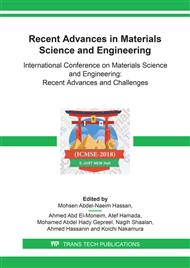[1]
M. Cohen, U.S. Patent, US 6,289,781 B1, (2001).
Google Scholar
[2]
G. Simovich, U. S. Patent, US 8628857 B2, (2011).
Google Scholar
[3]
C.T. Lim, V.P.W. Shim, Y.H. Ng, Finite-element modeling of the ballistic impact of fabric armor, Int. J. Impact Eng. 28 (2003) 13–31.
DOI: 10.1016/s0734-743x(02)00031-3
Google Scholar
[4]
M. Pagnoncelli, V. Piroli, D. Romanzini, I.M. Pereira, R. Rodrigues Dias, S.C. Amico, A.J. Zattera, Mechanical and ballistic analysis of aramid/vinyl ester composites, J. Compos. Mater. 52 (2018) 289–299.
DOI: 10.1177/0021998317705976
Google Scholar
[5]
D. George A., US Patent, (2011).
Google Scholar
[6]
T.P. Moor, World Intellectual Property Organization, WO2014200596A2, (2014).
Google Scholar
[7]
R.A. Carlson, Modular Ballistic Body Armor System with Cover Sleeve, US2015114212 (A1), (2015).
Google Scholar
[8]
E.A. Duodu, Comparison of Ballistic Impact Behavior of Carbon Fiber/Epoxy Composite and Steel Metal Structures, (2018) 10.
Google Scholar
[9]
S.S. Morye, P.J. Hine, R.A. Duckett, D.J. Carr, I.M. Ward, Modelling of the energy absorption by polymer composites upon ballistic impact, Compos. Sci. Technol. 60 (2000) 2631–2642.
DOI: 10.1016/s0266-3538(00)00139-1
Google Scholar
[10]
D. Bürger, A. Rocha de Faria, S.F.M. de Almeida, F.C.L. de Melo, M.V. Donadon, Ballistic impact simulation of an armour-piercing projectile on hybrid ceramic/fiber reinforced composite armours, Int. J. Impact Eng. 43 (2012) 63–77.
DOI: 10.1016/j.ijimpeng.2011.12.001
Google Scholar
[11]
P. Ma, L. Jin, L. Wu, Experimental and numerical comparisons of ballistic impact behaviors between 3D angle-interlock woven fabric and its reinforced composite, J. Ind. Text. (2018) 152808371875490.
DOI: 10.1177/1528083718754903
Google Scholar
[12]
A. Sharma, V.K. Dwivedi, Replacement of Kevlar With Spider Silk in Body Armour, (n.d.) 9.
Google Scholar
[13]
M.A.G. Silva, C. Cismaşiu, C.G. Chiorean, Numerical simulation of ballistic impact on composite laminates, Int. J. Impact Eng. 31 (2005) 289–306.
DOI: 10.1016/j.ijimpeng.2004.01.011
Google Scholar
[14]
T. Dhode, G. Patil, E. Rajkumar, Impact analysis of side door of a car and bullet proof vest with material SAM2X5-630, using finite element analysis, IOP Conf. Ser. Mater. Sci. Eng. 263 (2017) 062054.
DOI: 10.1088/1757-899x/263/6/062054
Google Scholar
[15]
A. Manes, D. Lumassi, G. Magrassi, M. Bordegoni, M. Giglio, Micro-Scale Analysis and Simulation on the behavior of a component in Al-6061during ballistic impact: 3D acquisition and FE model, Procedia Eng. 10 (2011) 3435–3440.
DOI: 10.1016/j.proeng.2011.04.566
Google Scholar
[16]
S. Feli, M.R. Asgari, Finite element simulation of ceramic/composite armor under ballistic impact, Compos. Part B Eng. 42 (2011) 771–780.
DOI: 10.1016/j.compositesb.2011.01.024
Google Scholar
[17]
K. Krishnan, S. Sockalingam, S. Bansal, S.D. Rajan, Numerical simulation of ceramic composite armor subjected to ballistic impact, Compos. Part B Eng. 41 (2010) 583–593.
DOI: 10.1016/j.compositesb.2010.10.001
Google Scholar
[18]
Z. Fawaz, W. Zheng, K. Behdinan, Numerical simulation of normal and oblique ballistic impact on ceramic composite armours, Compos. Struct. 63 (2004) 387–395.
DOI: 10.1016/s0263-8223(03)00187-9
Google Scholar
[19]
L. Jin, H. Hu, B. Sun, B. Gu, A simplified microstructure model of bi-axial warp-knitted composite for ballistic impact simulation, Compos. Part B Eng. 41 (2010) 337–353.
DOI: 10.1016/j.compositesb.2010.03.006
Google Scholar
[20]
K.S. Pandya, M.D. Kulkarni, A. Warman, N.K. Naik, Simulation of stress wave attenuation in plain weave fabric composites during in-plane ballistic impact, Compos. Struct. 160 (2017) 748–757.
DOI: 10.1016/j.compstruct.2016.10.115
Google Scholar
[21]
P.J. McKee, A.C. Sokolow, J.H. Yu, L.L. Long, E.D. Wetzel, Finite element simulation of ballistic impact on single jersey knit fabric, Compos. Struct. 162 (2017) 98–107.
DOI: 10.1016/j.compstruct.2016.11.086
Google Scholar
[22]
P. Turner, T. Liu, X. Zeng, K. Brown, Three-dimensional woven carbon fibre polymer composite beams and plates under ballistic impact, Compos. Struct. 185 (2018) 483–495.
DOI: 10.1016/j.compstruct.2017.10.091
Google Scholar
[23]
R.P. Nair, C.L. Rao, Simulation of depth of penetration during ballistic impact on thick targets using a one-dimensional discrete element model, Sadhana. 37 (2012) 261–279.
DOI: 10.1007/s12046-012-0079-z
Google Scholar
[24]
Y. Xiao, H. Dong, Studying Normal and Oblique Perforation of Steel Plates with SPH Simulations, Int. J. Appl. Mech. 09 (2017) 1750091.
DOI: 10.1142/s1758825117500910
Google Scholar
[25]
H. Frissane, L. Taddei, N. Lebaal, S. Roth, SPH modeling of high velocity impact into ballistic gelatin. Development of an axis-symmetrical formulation, Mech. Adv. Mater. Struct. (2018) 1–8.
DOI: 10.1080/15376494.2018.1452322
Google Scholar
[26]
G. Sabadin, M. Gaiotti, C.M. Rizzo, A. Bassano, Development and validation of a numerical model for the simulation of high-velocity impacts on advanced composite armor systems, Nonlinear Dyn. 91 (2018) 1791–1816.
DOI: 10.1007/s11071-017-3981-4
Google Scholar
[27]
J.J. Monaghan, Smoothed particle hydrodynamics, Rep. Prog. Phys. 68 (2005) 1703–1759.
DOI: 10.1088/0034-4885/68/8/r01
Google Scholar
[28]
Y. He, Z. Zhou, W. Cao, W. Chen, Simulation of mould filling process using smoothed particle hydrodynamics, Trans. Nonferrous Met. Soc. China. 21 (2011) 2684–2692.
DOI: 10.1016/s1003-6326(11)61111-4
Google Scholar
[29]
A. Monsalve, F.D. Barbieri, M. Gómez, A. Artigas, L. Carvajal, K. Sipos, O. Bustos, J. Pérez-Ipiña, Mechanical Behavior of a Twip Steel (Twinning Induced Plasticity), Matér. Rio Jan. 20 (2015) 653–658.
DOI: 10.1590/s1517-707620150003.0067
Google Scholar
[30]
H. Levanger, Simulating Ductile Fracture in Steel using the Finite Element Method: Comparison of Two Models For Describing Local Instability due to Ductile Fracture. by, (n.d.) 135.
Google Scholar
[31]
H. Hooputra, H. Gese, H. Dell, H. Werner, A comprehensive failure model for crashworthiness simulation of aluminium extrusions, Int. J. Crashworthiness. 9 (2004) 449–464.
DOI: 10.1533/ijcr.2004.0289
Google Scholar


